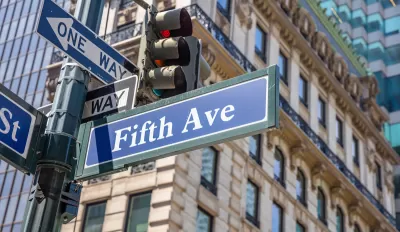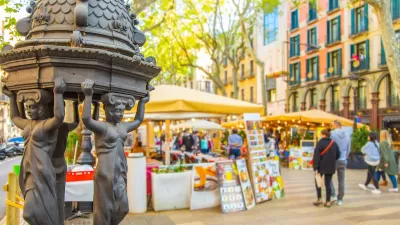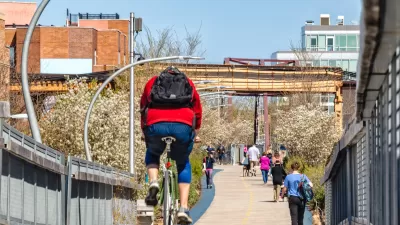Visitors to the iconic shopping street overwhelmingly arrive by walking, transit, or bike. Why are bike and pedestrian infrastructure improvement lagging so far behind another famous NYC street, Broadway?

Writing in Streetsblog NYC, Barak Friedman, Paul Krikler, and Janet Liff compare the adaptations of two iconic New York City streets to 21st century conditions: “while Broadway continues to transform into a world class destination, becoming more pedestrian and bike friendly, Fifth Avenue struggles.”
While Broadway is becoming increasingly pedestrianized and bike-friendly, Fifth Avenue languishes as e-commerce and commercial real estate vacancies leave the fabled shopping street emptier and emptier. According to the authors, former Mayor Bill de Blasio’s devision to nix a ‘compelte street’ plan for Fifth Avenue in 2021 “is sabotaging business interests and hurting the larger midtown post-pandemic recovery.”
A recent survey shows that crowded sidewalks make visitors to Fifth Avenue less likely to linger and shop. The same survey reveals that “Of the 226 people surveyed on Fifth Avenue, only 3 percent of people (seven people total) reached Fifth Avenue by using a private car or ride share. Some 97 percent of people walked, used public transit, or cycled.” And “Almost 70 percent of respondents indicated that they would be “more inclined” to cycle on Fifth Avenue with the addition of a protected bike lane.”
The authors conclude that in this case, more than others, “the interests of safety activists, the interests of business stakeholders, and the greater benefit to New York City are aligned.” Improved bike and pedestrian infrastructure on Fifth Avenue would benefit visitors, businesses, and Midtown Manhattan as a whole.
FULL STORY: Two Paths Forward: Broadway Shows What Could Be on Fifth Avenue

Study: Maui’s Plan to Convert Vacation Rentals to Long-Term Housing Could Cause Nearly $1 Billion Economic Loss
The plan would reduce visitor accommodation by 25,% resulting in 1,900 jobs lost.

North Texas Transit Leaders Tout Benefits of TOD for Growing Region
At a summit focused on transit-oriented development, policymakers discussed how North Texas’ expanded light rail system can serve as a tool for economic growth.

Why Should We Subsidize Public Transportation?
Many public transit agencies face financial stress due to rising costs, declining fare revenue, and declining subsidies. Transit advocates must provide a strong business case for increasing public transit funding.

Dear Tesla Driver: “It’s not You, It’s Him.”
Amidst a booming bumper sticker industry, one writer offers solace to those asking, “Does this car make me look fascist?”

A Visual Celebration of Manhattan’s Chinatown Elder Community, Through Food
Lanterns, cafeteria trays, and community connection take center stage in this stunning photo essay.

How to Make US Trains Faster
Changes to boarding platforms and a switch to electric trains could improve U.S. passenger rail service without the added cost of high-speed rail.
Urban Design for Planners 1: Software Tools
This six-course series explores essential urban design concepts using open source software and equips planners with the tools they need to participate fully in the urban design process.
Planning for Universal Design
Learn the tools for implementing Universal Design in planning regulations.
City of Santa Clarita
Ascent Environmental
Institute for Housing and Urban Development Studies (IHS)
City of Grandview
Harvard GSD Executive Education
Toledo-Lucas County Plan Commissions
Salt Lake City
NYU Wagner Graduate School of Public Service





























